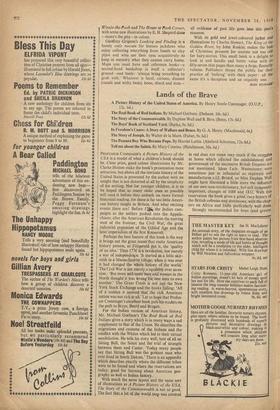As illustrator of the best but one children's book since
the war (The Happy Lion) we expect a lot from Roger Duvoisin, who has written as well as illustrated Petunia. Petunia is a goose who learns through hubris and nemesis what wisdom is. Her initial mistake was one anyone might make. Someone was heard saying, 'he who owns books and loves them "is wise.' So she took a bOok everywhere with her and loved it, but instead of growing wise. she grew frightfully proud. Her advice to other animals was not in the least help- ful, though by now she was too proud to notice the fact. Disaster was inevitable, but out of it came the beginning of wisdom. A good story with confident, happy pictures, but the superb economy and organic unity of the earlier book is missing.
Another moral tale, almost equally good and with a more sympathetic heroine, is The Unhappy Hippopotamus. For Harriet, who tried to be all sorts of other things, and simply couldn't smile, things looked black indeed until she once again felt the mud beneath her feet. Her clothes slide up her wrinkled torso and she is back where she started, a happy hippopotamus. If it hadn't been for The Pirate Twins, nearly the best as well as quite the shortest of children's stories (105 words), one would have given top prize 'to Clever Bill. But William Nicholson, responsible for both, made his second story 149 words long, and this is a bit too much. Still, for those who know The Pirate Twins it will be enough to hear that another from the same remarkable mind is again available. Newcomers should begin with Clever Bill. Bettina, the illustrator of Piruwayu and the Rainbow, has good claim to be the best living artist for children's books. It is a pity that she is not more often allowed to tell her own stories in her own words as well, for when she does, as in Angelo and Rosaline, she shows herself a story-teller in the grand tradition. Her set of illustrations for Pirttwayu are as good as any- thing she has done, but the remote setting and atmosphere of these short episodes are not worthy of her talents. The Wizard of Oz, by L. Frank Baum, blows into all this rarefied art non- sense like a loud raspberry. Handpicked from the merchandising department, it is a huge, tasteless international bit of work, ghoulishly illustrated, as glossy as a record sleeve.
Finally, Eloise in Paris. Ballyhoo and attendant byproducts are all at Work to make us Eloise- conscious and Eloise-resentful. Let us be fair to the author and to Hilary Knight, whose pictures are more telling and rather less knowing than the text. The first few 'pages will keep most people in stitches. But eventually laughter dies away. There is only one joke, which isEloise, and she is far too long sustained. There is no story, only Eloise's re- action to Paris, France. Where all the girl's money comes from, why all the skivvies don't throw cau- tion to the wind and strangle her, what she is going to do with all those terrible traumas when she grows up—well nobody really cares. As part of the ballyhoo, many personalities of show business testify to their love of Eloise on the back of the wrapper. Amongst them, Robert Morley says, recommend Eloise' (he does not say what for). A cat may look at a king, and my own quote is that, like rather a lot of children especially fic- tion, Eloise is hell.
ROBIN DENN1STON ■ 17 'Magnificent holiday stuIT' said Naomi Lewis in The Observer when the first two Tintin books were published recently. The hero of full-colour cartoon books by the artist Herge, Tintin is a household name on the Continent:
HARDING































































 Previous page
Previous page